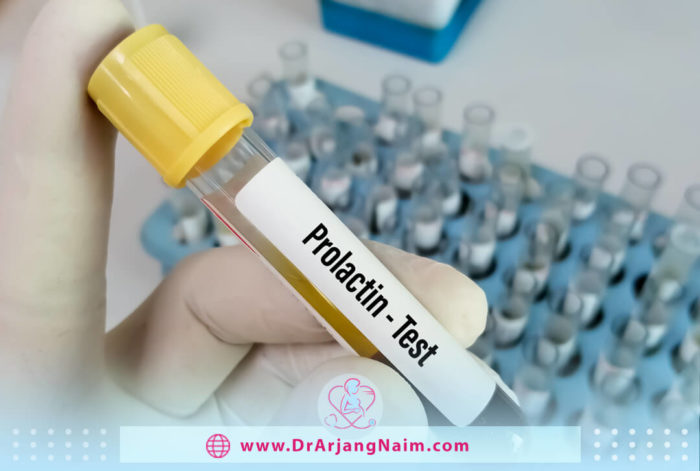Prolactinoma is a noncancerous tumor of the pituitary gland. The pituitary is a pea-sized gland at the base of the brain. It makes several different hormones, including a hormone called prolactin. Prolactin affects the mammary glands and helps women produce breast milk.
Prolactinoma causes the pituitary gland to produce too much of a hormone called prolactin. The main effect of prolactinoma is to reduce some sex hormones (estrogen in women and testosterone in men). Although prolactinoma is not life-threatening, it can cause vision problems, infertility, and other problems. Doctors can often treat this disorder with medication to get prolactin levels back to normal. Surgery to remove the pituitary tumor may also be an option.
What is prolactin?
Prolactin is a hormone mainly responsible for mammary glands’ growth in breast tissue, milk production, and lactation. It also helps with several processes and functions of the body. The pituitary gland is mainly responsible for the production and secretion of prolactin, but the central nervous system, immune system, uterus, and mammary glands can also produce prolactin. Prolactin levels are usually low in both men and non-lactating and non-pregnant, but they are usually high in pregnant or breastfeeding people.
Symptoms

The symptoms of prolactinoma are different in men and women. For women, common symptoms include:
- Irregular menstrual periods
- Lack of menstrual periods
- Low sex drive
- Problems with fertility
- Painful intercourse (caused by vaginal dryness)
- Unusual production of breast milk
Because changes in a woman’s menstrual cycle are evident, prolactinoma occurs earlier in postmenopausal women.
Postmenopausal women who no longer menstruate may not notice symptoms when the tumor is small. As it grows, it may put pressure on other adjacent tissues. Symptoms can then include vision loss, vision changes, and headaches. Prolactinoma occurs earlier in premenopausal women.
When a man is diagnosed with prolactinoma, it tends to be large. Men are often not diagnosed with the initial symptoms, which include:
- Breast milk production in rare cases
- Problems getting or maintaining an erection
- Decreased interest in sex
Headaches or vision problems are usually symptoms that men bring to the doctor.
How common are prolactinomas?
Small, non-cancerous pituitary tumors are relatively common in the general population. Approximately 40% of pituitary tumors are prolactinomas, making it the most common type of pituitary tumor.
Prolactinomas are usually classified into two groups: microadenomas less than 1 cm and macroadenomas larger than 8 mm. Size may play a role in the symptoms of local compression and determine the treatment of choice.
Causes of Prolactemia
Prolactinoma is a type of tumor that develops in the pituitary gland. The cause of these tumors is unknown. The pituitary gland is a small bean-shaped gland located at the base of the brain. Despite its small size, this gland affects almost all body parts. Its hormones help regulate important functions such as growth, metabolism, blood pressure, and reproduction. Other possible causes of prolactin overproduction include medications, different types of pituitary tumors, an underactive thyroid gland, persistent chest irritation, pregnancy, and breastfeeding.
Complications
Side effects may include the following:
- Bone loss (osteoporosis): Excess prolactin can reduce the production of the hormones estrogen and testosterone, thereby reducing bone density and increasing the risk of osteoporosis.
- Pregnancy complications: During a normal pregnancy, estrogen production increases. If you are pregnant and have large prolactinomas, these high estrogen levels may cause the tumor to grow and associated symptoms, such as headaches and changes in vision.
- Vision loss: If left untreated, prolactinoma may become large enough to compress the optic nerve. This can cause a loss of environmental vision.
- Low levels of other pituitary hormones: In this disease, pressure on the pituitary gland can lead to decreased levels of other pituitary-controlled hormones, including thyroid hormones and cortisol.
Other factors that can increase prolactin levels
In some people, high blood prolactin levels can be caused by reasons other than prolactinoma. Other causes include:
- Prescription drugs: The secretion of prolactin in the pituitary gland is usually suppressed by a brain chemical called dopamine. Drugs that block the effects of dopamine on the pituitary gland or reduce dopamine stores in the brain may cause prolactin to be secreted from the pituitary gland. These include the main sedatives trifluoperazine and haloperidol, as well as metoclopramide (used to treat gastroesophageal reflux disease and nausea caused by some cancer drugs).
- Other pituitary tumors: Other tumors may block dopamine flow from the brain, which is normally inhibiting by prolactin-secreting cells. Such so-called “mixed” tumors form inside or near the pituitary gland and include those that release too much growth hormone (acromegaly) or stimulate cortisol production (Cushing’s syndrome). They can also cause the pituitary gland to secrete more prolactin.
- Some nonpituitary tumors: Prolactin secretion can also be caused by some cancers, such as lung cancer.
- Hypothyroidism: Elevated prolactin levels are more common in people with hypothyroidism, and doctors routinely test people with hyperprolactinemia for hypothyroidism.
- Breast stimulation: Breast stimulation can increase prolactin levels in the blood by an average.
- Chest wall trauma: For example, damage to the steering wheel of a car after an accident can lead to elevated prolactin levels.
- Marijuana: Marijuana use is a proven cause of elevated prolactin levels.
Diagnosis

If a person experiences symptoms of prolactinoma, the doctor may recommend tests such as blood tests and imaging tests to confirm or rule it out.
Prolactin level blood test
If the blood test results show that blood prolactin level is higher than normal, the doctor may perform an imaging test to confirm or rule out a prolactinoma diagnosis.
MRI (magnetic resonance imaging) scan
The preferred imaging test for prolactinoma is an MRI scan. This method uses radio waves and magnets to create accurate images of internal organs and soft tissues. An MRI scan can help the provider locate a prolactinoma and determine its size.
CT (computed tomography) scan
If there is a pacemaker or metal implant in the body, an MRI may not be possible. In this case, the doctor replaces the CT scan. CT uses a set of X-ray images taken from different angles and a computer to create images of tissues inside the body. The CT scan results help the doctor confirm the diagnosis of prolactinoma and determine its size and location.
Testosterone level blood test
If a man has symptoms of elevated prolactin, his doctor will also test his blood testosterone level. Low testosterone levels can help confirm the diagnosis of prolactinoma.
Treatment
The goals of treatment are:
- Restore normal function of the pituitary gland
- Reduce the size of the pituitary tumor
- Return prolactin production to normal levels
- Improve the quality of life
- Eliminate any signs or symptoms of tumor strain, such as headaches or vision problems
Treatment generally consists of two main methods: medications and surgery.
Medications

Oral medications can often reduce prolactin production and relieve symptoms. Medications may also shrink the tumor. However, long-term treatment with medications is generally necessary. Doctors use drugs called dopamine agonists for treatment. These drugs mimic the effects of dopamine (a brain chemical that typically controls prolactin production). Commonly prescribed drugs include bromocriptine and cabergoline. These drugs reduce prolactin production and may shrink the tumor in most people.
Common side effects
Nausea and vomiting, nasal congestion, headache, and drowsiness are common side effects of these drugs. However, these side effects can often be minimized if the doctor starts with a very low dose of the medicine and gradually increases the dose. If the drug significantly shrinks the tumor and prolactin levels remain normal for two years, the patient may be able to reduce the drug with a doctor’s advice. However, recurrence is common.
Surgery
If drug treatment is not effective or the drug cannot be tolerated, surgery to remove the tumor is an option. Surgery may be needed to reduce the pressure on the nerves that control vision. The type of surgery largely depends on the size of the tumor.
Nasal surgery

Most people who need surgery have a procedure in which the tumor is removed through the nasal cavity. This is called transsphenoidal surgery. The complication rate is low because no other area of the brain is touched during surgery, and the surgery leaves no visible scars.
Transcranial surgery
If the tumor is large or has spread to tissue adjacent to the brain, this procedure may be needed, also known as a craniotomy. The surgeon removes the tumor through the upper part of the skull.
The outcome of surgery depends on the size and location of the tumor and the level of prolactin before surgery, as well as the skill of the surgeon. The higher the prolactin level, the less likely that prolactin production will return to normal after surgery.
Surgery corrects prolactin levels in most people with small pituitary tumors. However, many pituitary tumors recur within five years of surgery. For people with larger tumors that are only partially removable, medication can often bring prolactin levels back to normal after surgery.
Radiation
Radiation therapy is a rare third treatment option if medications or surgery are ineffective in lowering prolactin levels. X-rays or high-energy particle waves are used to kill tumor cells. Depending on the size and location of the tumor, a single dose of radiation or several doses over several weeks may be prescribed. Side effects include:
- Vision loss (rare side effect)
- Brain injury (rare side effect)
- Low levels of thyroid hormone (most common side effect)
- A decrease in levels of other pituitary gland hormones
Does a prolactinoma affect pregnancy?
If a woman has a small prolactinoma, there is usually no reason why she will not be able to conceive and have a normal pregnancy after successful medical treatment.
During a normal pregnancy in women without a pituitary gland, the pituitary gland enlarges, and prolactin production increases. Women with prolactin-secreting tumors may experience more pituitary enlargement and should be closely monitored during pregnancy. However, damage to the pituitary gland or nerves of the eye occurs in less than one percent of pregnant women with prolactinoma. If a woman has already had a successful pregnancy, a successful pregnancy in the future is very high.
A woman with prolactinoma should discuss her plans for pregnancy with her doctor . This evaluation usually includes a magnetic resonance imaging (MRI) scan to assess the size of the tumor and an eye exam to measure the visual fields.
When a patient becomes pregnant, her doctor will usually advise her to stop taking bromocriptine or cabergoline. Patients should consult their hormonal specialists immediately if they experience symptoms, especially headache, vision changes, nausea, vomiting, excessive thirst, and severe lethargy. If symptoms occur due to tumor growth during pregnancy, treatment with bromocriptine or cabergoline may be renewed, and additional treatment may be needed.
The bottom line
Hormones play an important role in the health of our body. So, if there is a problem with one of the hormones and that hormone is not secreting naturally, it can cause many problems. One of the most important hormones that men and women naturally have small amounts of in their blood is the hormone prolactin.
Prolactin is one of the important hormones, and if its secretion is disturbing, many problems for the body’s hormonal system will occur. This hormone can cause many problems if it is secreted too much. People with Prolactinoma should be monitored by a doctor to be controlled with medication or surgery.
Dr. Arjang Naim, MD, performs the necessary tests on women who are planning to become pregnant or are pregnant to check the level of the hormone prolactin and take the necessary treatment if it is high.
Additional questions
- What is prolactin responsible for?
Prolactin is a hormone responsible for breastfeeding, breast tissue growth, and milk production. Elevated levels of prolactin in the blood can cause certain symptoms, such as irregular periods, infertility, and erectile dysfunction.
- What foods reduce prolactin levels?
Foods that lower prolactin levels generally contain zinc. The most important foods containing zinc include oysters, beef, turkey, and beans. It is also important to get plenty of B6, so foods such as potatoes, bananas, wild salmon, chicken, and spinach can help increase levels of this vitamin.
- How does prolactin affect fertility?
High levels of prolactin inhibit the secretion of FSH, a hormone that causes ovulation. Therefore, if prolactin levels are high, ovulation may not occur. This is why breastfeeding women usually do not get pregnant.
- Does high prolactin cause low estrogen?
Excess prolactin can reduce the production of the hormones estrogen and testosterone, thereby reducing bone density and increasing the risk of osteoporosis.
- What is the pituitary gland?
The pituitary gland is part of the endocrine system. Its main function is to secrete hormones into the bloodstream. These hormones can affect other organs and glands, especially:
- Thyroid
- Reproductive organs
- Adrenal glands
References:
https://www.mayoclinic.org/diseases-conditions/prolactinoma/doctors-departments/ddc-20376963
https://www.webmd.com/cancer/prolactinoma-tumor
https://my.clevelandclinic.org/health/diseases/22007-prolactinoma#diagnosis-and-tests
https://www.medicinenet.com/prolactinoma/article.htm#prolactinoma_facts




